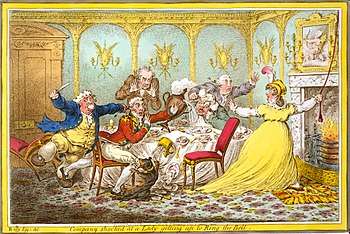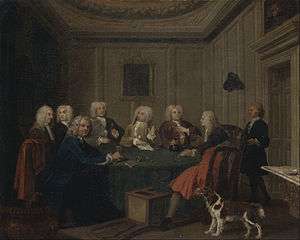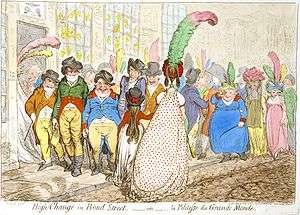Etiquette
Etiquette (/ˈɛtɪkɛt/ and /ˈɛtɪkɪt/; French: [e.ti.kɛt]) is the set of conventional rules of personal behaviour in polite society, usually in the form of an ethical code that delineates the expected and accepted social behaviors that accord with the conventions and norms observed by a society, a social class, or a social group. In modern English usage, the French word étiquette (ticket) dates from the year 1750.[2]

History

In the 3rd millennium BC, the Ancient Egyptian vizier Ptahhotep wrote The Maxims of Ptahhotep (2375–2350 BC), a book of didactic precepts extolling civil virtues, such as truthfulness, self-control, and kindness towards other people. Recurrent thematic motifs in the maxims include learning by listening to other people, and that being mindful of the imperfection of human knowledge, avoiding open conflict, wherever possible, should not be considered weakness; and that the pursuit of justice should be foremost, yet acknowledged that, in human affairs, the command of a god ultimately prevails in all matters. Some maxims indicate a person's correct behaviours in the presence of great personages (political, military, religious). Instructions on how to choose the right master and how to serve him. Other maxims teach the correct way to be a leader, through openness and kindness, and that greed is the base of all evil, and should be guarded against, and that generosity towards family and friends is praiseworthy.
Confucius (551–479 BC) was the Chinese intellectual and philosopher whose works emphasized personal and governmental morality, correctness of social relationships, the pursuit of justice in personal dealings, and sincerity in all personal relations.
Baldassare Castiglione (1478–1529), count of Casatico, was an Italian courtier and diplomat, soldier, and author of The Book of the Courtier (1528), an exemplar courtesy book dealing with questions of the etiquette and morality of the courtier during the Italian Renaissance.
Louis XIV (1638–1715), King of France, used a codified etiquette to tame the French nobility and assert his supremacy as the absolute monarch of France. In consequence, the ceremonious royal court favourably impressed foreign dignitaries whom the king received at the seat of French government, the Palace of Versailles, to the south-west of Paris.[3]
Politeness


In the 18th century, during the Age of Enlightenment, the adoption of etiquette was a self-conscious process for acquiring the conventions of politeness and the normative behaviours (charm, manners, demeanour) which symbolically identified the person as a genteel member of the upper class. To identify with the social élite, the upwardly mobile middle class and the bourgeoisie adopted the behaviours and the artistic preferences of the upper class. To that end, socially ambitious people of the middle classes occupied themselves with learning, knowing, and practising the rules of social etiquette, such as the arts of elegant dress and gracious conversation, when to show emotion, and courtesy with and towards women.[4]
In the early 18th century, Anthony Ashley-Cooper, 3rd Earl of Shaftesbury, wrote influential essays that defined politeness as the art of being pleasing in company; and discussed the function and nature of politeness in the social discourse of a commercial society:
'Politeness' may be defined as dext'rous management of our words and actions, whereby we make other people have better opinion of us and themselves.[5]
Periodicals, such as The Spectator, a daily publication founded in 1711 by Joseph Addison and Richard Steele, regularly advised their readers on the etiquette required of a gentleman, a man of good and courteous conduct; their stated editorial goal was "to enliven morality with wit, and to temper wit with morality . . . to bring philosophy out of the closets and libraries, schools and colleges, to dwell in clubs and assemblies, at tea-tables and coffeehouses"; to which end, the editors published articles written by educated authors, which provided topics for civil conversation, and advice on the requisite manners for carrying a polite conversation, and for managing social interactions.[6]
In the American colonies, Benjamin Franklin and George Washington wrote codes of conduct for young gentlemen. The immense popularity of advice columns and books by Letitia Baldrige and Miss Manners shows the currency of this topic. Even more recently, the rise of the Internet has necessitated the adaptation of existing rules of conduct to create Netiquette, which governs the drafting of e-mail, rules for participating in an online forum, and so on.
Conceptually allied to etiquette is the notion of civility (social interaction characterised by sober and reasoned debate) which for socially ambitious men and women also became an important personal quality to possess for social advancement.[7] In the event, gentlemen's clubs, such as Harrington's Rota Club, published an in-house etiquette that codified the civility expected of the members. Besides The Spectator, other periodicals sought to infuse politeness into English coffeehouse conversation, the editors of The Tatler were explicit that their purpose was the reformation of English manners and morals; to those ends, etiquette was presented as the virtue of morality and a code of behaviour.[8]
In the mid-18th century, the first, modern English usage of etiquette (the conventional rules of personal behaviour in polite society) was by Philip Stanhope, 4th Earl of Chesterfield, in the book Letters to His Son on the Art of Becoming a Man of the World and a Gentleman (1774),[9] a correspondence of more than 400 letters written from 1737 until the death of his son, in 1768; most of the letters were instructive, concerning varied subjects that a worldly gentleman should know.[10] The letters were first published in 1774, by Eugenia Stanhope, the widow of the diplomat Philip Stanhope, Chesterfield's bastard son. Throughout the correspondence, Chesterfield endeavoured to decouple the matter of social manners from conventional morality, with perceptive observations that pragmatically argue to Philip that mastery of etiquette was an important means for social advancement, for a man such as he. Chesterfield's elegant, literary style of writing epitomised the emotional restraint characteristic of polite social intercourse in 18th-century society:
I would heartily wish that you may often be seen to smile, but never heard to laugh while you live. Frequent and loud laughter is the characteristic of folly and ill-manners; it is the manner in which the mob express their silly joy at silly things; and they call it being merry. In my mind there is nothing so illiberal, and so ill-bred, as audible laughter. I am neither of a melancholy nor a cynical disposition, and am as willing and as apt to be pleased as anybody; but I am sure that since I have had the full use of my reason nobody has ever heard me laugh.
In the 19th century, Victorian era (1837–1901) etiquette had developed into a complicated system of codified behaviours, which governed the range of manners in society — from the proper language, style, and method for writing letters, to correctly using cutlery at table, and to the minute regulation of social relations and personal interactions between men and women and among the social classes.[11]
Manners

Sociological perspectives
In a society, manners are described as either good manners or as bad manners to indicate to a person whether or not his or her behavior is acceptable to the cultural group. As such, manners enable ultrasociality and are integral to the functioning of the social norms and conventions that are informally enforced through personal self-regulation in public life and in private life. The perspectives of sociology indicate that manners are a means for men and women to display their social status, and a means of demarcating, observing, and maintaining the boundaries of social identity and of social class.[12]
In The Civilizing Process (1939), the sociologist Norbert Elias said that manners arose as a product of group living, and persist as a way of maintaining social order. That manners proliferated during the Renaissance in response to the development of the ‘absolute state’ — the progression from small-group living to large-group living characterised by the centralized power of the State. That the rituals and manners associated with the royal court of England during that period were closely bound to a person's social status. That manners demonstrate a person's position within a social network, and that a person's manners are a means of negotiation from that social position.[13]
From the perspective of public health, in The Healthy Citizen (1996), Alana R. Petersen and Deborah Lupton said that manners assisted the diminishment of the social boundaries that existed between the public sphere and the private sphere of a person's life, and so gave rise to “a highly reflective self, a self who monitors his or her behavior with due regard for others with whom he or she interacts, socially”; and that “the public behavior of individuals came to signify their social standing; a means of presenting the self and of evaluating others, and thus the control of the outward self was vital.”[14]
Moreover, the sociologist Pierre Bourdieu applied the concept of habitus towards understanding the societal functions of manners. The habitus is the set of mental attitudes, personal habits, and skills that a person possesses, his and her dispositions of character that are neither self-determined, nor pre-determined by the external environment, but which are produced and reproduced by social interactions; and are “inculcated through experience and explicit teaching” — yet tend to function at the subconscious level.[15] Therefore, manners are likely to be a central part of the dispositions that guide a person’s ability to decide upon socially-compliant behaviours.[16]
Anthropological perspectives
In Purity and Danger: An Analysis of Concepts of Pollution and Taboo (2003) the anthropologist Mary Douglas said that the unique manners, social behaviors, and group rituals enable the local cosmology to remain ordered and free from those things that may pollute or defile the integrity of the culture. That ideas of pollution, defilement, and disgust are attached to the margins of socially acceptable behaviour in order to curtail unacceptable behaviour, and so maintain “the assumptions by which experience is controlled” within the culture.[17]
Evolutionary perspectives
In studying the expression of emotion by humans and animals, the naturalist Charles Darwin noted the universality of facial expressions of disgust and shame among infants and blind people, and concluded that the emotional responses of shame and disgust are innate behaviours.[18] The public health specialist Valerie Curtis said that the development of facial responses was concomitant with the development of manners, which are behaviours with an evolutionary role in preventing the transmission of diseases, thus, people who practise personal hygiene and politeness will most benefit from membership in their social group, and so stand the best chance of biological survival, by way of opportunities for reproduction.[19]
From the study of the evolutionary bases of prejudice, the social psychologists Catherine Cottrell and Steven Neuberg said that human behavioural responses to ‘otherness’ might enable the preservation of manners and social norms.[20] That the feeling of "foreignness" — which people experience in their first social interaction with someone from another culture — might partly serve an evolutionary function: 'Group living surrounds one with individuals [who are] able to physically harm fellow group members, to spread contagious disease, or to "free ride" on their efforts'; therefore, a commitment to sociality is a risk: 'If threats, such as these, are left unchecked, the costs of sociality will quickly exceed its benefits. Thus, to maximize the returns on group "living", individual group members should be attuned to others’ features or behaviors.'[20]
Therefore, people who possess the social traits common to the cultural group are to be trusted, and people without the common social traits are to be distrusted as ‘others’, and thus treated with suspicion or excluded from the group. That pressure of social exclusivity, born from the shift towards communal living, excluded uncooperative people and persons with poor personal hygiene. The threat of social exclusion led people to avoid personal behaviours and that might embarrass the group or that might provoke revulsion among the group.[21]
To demonstrate the transmission of social conformity, the anthropologists Joseph Henrich and Robert Boyd developed a behavioural model indicating that manners are a means of mitigating social differences, curbing undesirable personal behaviours, and fostering co-operation within the social group. That natural selection has favoured the acquisition of genetically-transmitted mechanisms for learning, thereby increasing a person's chances for acquiring locally adaptive behaviours: “Humans possess a reliably developing neural encoding that compels them both to punish individuals who violate group norms (common beliefs or practices) and [to] punish individuals who do not punish norm-violators.”[22]
Categories
Social manners are in three categories: (i) manners of hygiene, (ii) manners of courtesy, and (iii) manners of cultural norm, each category accounts for an aspect of the functional role that manners play in a society. The categories of manners are based upon the social outcome of behaviour, rather than upon the personal motivation of the behaviour. As a means of social management, the rules of etiquette encompass most aspects of human social interaction; thus, a rule of etiquette reflects an underlying ethical code, and can reflect a person's fashion and social status.[21]
(i) Hygiene Manners — are the manners that concern avoiding the transmission of disease, and usually are taught by the parent to the child by way of parental discipline, positive behavioural enforcement of body-fluid continence (toilet training), and the avoidance of and removal of disease vectors that risk the health of children. To that effect, society expects that, by adulthood, the manners for personal hygiene have become a second-nature behaviour, the violations of which shall provoke physical and moral disgust.
(ii) Courtesy Manners — are the manners of self-control and good-faith behaviour, by which a person gives priority to the interests of another person, and priority to the interests of a socio-cultural group, in order to be a trusted member of that group. Courtesy manners maximize the benefits of group-living, by regulating the nature of social interactions; however, the performance of courtesy manners occasionally interferes with the avoidance of communicable disease. Generally, parents teach courtesy manners in the same way they teach hygiene manners, but the child also learns manners directly (by observing the behaviour of other people in their social interactions) and by imagined social interactions (through the executive functions of the brain). A child usually learns courtesy manners at an older age than when he or she was toilet trained (taught hygiene manners), because learning the manners of courtesy requires that the child be self-aware and conscious of social position, which then facilitate understanding that violations (accidental or deliberate) of social courtesy will provoke peer disapproval within the social group.
(iii) Cultural Norm Manners — are the manners of culture and society by which a person establishes his and her identity and membership in a given socio-cultural group. In observing and abiding the manners of cultural norm, a person demarcates socio-cultural identity and establishes social boundaries, which then identify whom to trust and whom to distrust as 'the other', who is not the self. Cultural norm manners are learnt through the enculturation with and the routinisation of ‘the familiar’, and through social exposure to the ‘cultural otherness’ of people identified as foreign to the group. Transgressions and flouting of the manners of cultural norm usually result in the social alienation of the transgressor. The nature of culture-norm manners allows a high level of between-group variability, but the manners usually are common to the people who identify with the given socio-cultural group.[21]
Courtesy books
- 16th century
The Book of the Courtier (1528), by Baldassare Castiglione, identified the manners and the morals required by socially ambitious men and women for success in a royal court of the Italian Renaissance (14th–17th c.); as an etiquette text, The Courtier was an influential courtesy book in 16th-century Europe.
On Good Manners for Boys (1530), by Erasmus of Rotterdam, instructs boys in the means of becoming a young man; how to walk and talk, speak and act in the company of adults. The practical advice for acquiring adult self-awareness includes explanations of the symbolic meanings — for adults — of a boy's body language when he is fidgeting and yawning, scratching and bickering. On completing Erasmus's curriculum of etiquette, the boy has learnt that civility is the point of good manners; the adult ability to 'readily ignore the faults of others, but avoid falling short, yourself,' in being civilised.[23]
- 20th century
Etiquette in Society, in Business, in Politics, and at Home (1922), by Emily Post documents the "trivialities" of desirable conduct in daily life, and provided pragmatic approaches to the practice good manners; the social conduct expected and appropriate for the events of life, such as a baptism, a wedding, and a funeral.[24]
As didactic texts, books of etiquette (the conventional rules of personal behaviour in polite society) usually feature explanatory titles, such as The Ladies' Book of Etiquette, and Manual of Politeness: A Complete Hand Book for the Use of the Lady in Polite Society (1860), by Florence Hartley;[25] Amy Vanderbilt’s Complete Book of Etiquette (1957), by Amy Vanderbilt;[26] Miss Manners’ Guide to Excruciatingly Correct Behavior (1979), by Judith Martin;[27] and Peas & Queues: The Minefield of Modern Manners (2013), by Sandi Toksvig,[28] present ranges of civility; socially acceptable behaviours for their respective times; yet each author cautions the reader, that to be a well-mannered person he and she must practise good manners in their public and private lives. Moreover, the How Rude! comic-book series addresses and discusses adolescent perspectives and questions of etiquette, social manners, and civility.[29]
Business
In commerce, the purpose of etiquette is to facilitate the social relations necessary for realising the business transactions of buying and selling goods and services; in particular, the social interactions among the workers, and between labour and management. Business etiquette varies by culture, such as the Chinese and Australian approaches to conflict resolution. The Chinese business philosophy is based upon guanxi (personal connections), whereby person-to-person negotiation resolves difficult matters, whereas Australian business philosophy relies upon attorneys-at-law to resolve business conflicts through legal mediation;[30] thus, adjusting to the etiquette and professional ethics of another culture is an element of culture shock for businesspeople.[31]
In 2011, etiquette trainers formed the Institute of Image Training and Testing International (IITTI) a non-profit organisation to train personnel departments in measuring and developing and teaching social skills to employees, by way of education in the rules of personal and business etiquette, in order to produce business workers who possess standardised manners for successfully conducting business with people from other cultures.[32] In the retail branch of commerce, the saying: "The customer is always right." summarises the profit-orientation of good manners, between the buyer and the seller of goods and services:
There are always two sides to the case, of course, and it is a credit to good manners that there is scarcely ever any friction in stores and shops of the first class. Salesmen and women are usually persons who are both patient and polite, and their customers are most often ladies in fact as well as "by courtesy." Between those before and those behind the counters, there has sprung up in many instances a relationship of mutual goodwill and friendliness. It is, in fact, only the woman who is afraid that someone may encroach upon her exceedingly insecure dignity, who shows neither courtesy nor consideration to any except those whom she considers it to her advantage to please. Emily Post Etiquette 1922
See also
References
- Wright & Evans, Historical and Descriptive Account of the Caricatures of James Gillray (1851, OCLC 59510372), p. 473
- Etiquette, The New Shorter Oxford English Dictionary (1993) Lesley Brown, Ed., p. 858.
- "Louis XIV". History.com. Retrieved 13 December 2012.
- Lawrence E. Klein (1994). Shaftesbury and the Culture of Politeness: Moral Discourse and Cultural Politics in Early Eighteenth-Century England. Cambridge University Press. ISBN 9780521418065.
- Klein, Lawrence (1984). "The Third Earl of Shaftesbury and the Progress of Politeness". Eighteenth-Century Studies. 18 (2): 186–214. doi:10.2307/2738536. JSTOR 2738536.
- "Information Britain". Retrieved 13 September 2014.
- Cowan, 2005. p. 101.
- Mackie, 1998. p. 1.
- Henry Hitchings (2013). Sorry! The English and Their Manners. Hachette UK. Retrieved 2013-02-07.
- Mayo, Christopher "Letters to His Son", The Literary Encyclopedia, 25 February 2007 accessed 30 November 2011.
- Tudor Rose (1999–2010). "Victorian Society". AboutBritain.com. Retrieved 9 August 2010.
- Richerson and Boyd, "The Evolution of Human Ultra Sociality", in Ideology, Warfare, and Indoctrinability (1997), Eibl-Eibisfeldt I. and Salyer F. Eds.
- Norbert Elias, "The Civilizing Process", Oxford Blackwell Publishers, 1994
- Petersen A., Lupton D., "The Healthy Citizen" in The New Public Health — Discourses, Knowledges, Strategies (1996) London, SAGE.
- Jenkins R. "Pierre Bourdieu (Key Sociologists) (2002) Cornwall, Routledge.
- Bourdieu Pierre, "Outline of a Theory of Practice (1977) Cambridge, Cambridge University Press.
- Douglas M., "Purity and Danger – An Analysis of Concepts of Pollution and Taboo Archived 2013-08-17 at the Wayback Machine London, Routledge, 2003
- Darwin C., The Expression of the Emotions in Man and Animals London, Penguin, 2009
- Curtis V. Don’t Look, Don't Touch – The Science Behind Revulsion Archived 28 July 2014 at the Wayback Machine Oxford, Oxford University Press, 2013.
Curtis V., Aunger R., and Rabie T. "Evidence that Disgust Evolved to Protect from Risk of Disease Royal Society B: Biological Sciences, 271 Supplement: S131–33., 2004. - Neuberg SL., Cottrell CA. "Evolutionary Bases of Prejudices" in Evolution and Social Psychology, Schaller M. et al., Eds., New York, Psychology Press, 2006.
- Curtis V. "Don’t Look, Don't Touch — The Science Behind Revulsion" Archived 28 July 2014 at the Wayback Machine Oxford, Oxford University Press, 2013
- Henrich J., Boyd R. "The Evolution of Conformist Transmission and the Emergence of Between Group Differences" in Evolution and Human Behavior, 19(4):215–41, 1998.
- Rotterdam, E. of. A Handbook on Good Manners for Children: De civilitate morum puerilium libellus (1536) E. Merchant, Ed. (English tr.). London: Preface Publishing.
- Post, P., Post, A., Post, L., & Senning, D. P. Emily Post’s Etiquette, 18th Edition (2011) New York: William Morrow.
- Hartley, Florence (1860). "The Ladies' Book of Etiquette, and Manual of Politeness: A Complete Hand Book for the Use of the Lady in Polite Society". Boston: G. W. Cottrell.
- Vanderbilt, A. (1957) Amy Vanderbilt’s Complete Book of Etiquette New York: Doubleday & Company.
- Martin, J. (1979) Miss Manners’ Guide to Excruciatingly Correct Behavior New York: W. W. Norton & Company.
- Toksvig, S. (2013) Peas & Queues: The Minefield of Modern Manners London: Profile Books Ltd.
- Ellen R. Delisio, "Teaching Manners in a Manner-less World", Education World, 4 July 2005. Accessed 27 July 2018.
- Ho-Ching Wei. "Chinese-style Conflict Resolution: A Case of Taiwanese Business Immigrants in Australia" (PDF). University of Western Sydney. Archived from the original (PDF) on November 23, 2009. Retrieved June 2, 2012.
- De Mente, Boyd (1994). Chinese Etiquette & Ethics in Business. Lincolnwood: NTC Business Books. ISBN 0-8442-8524-2.
- "IITTI website "About Us"". Archived from the original on 13 September 2014. Retrieved 13 September 2014.
Further reading
- Baldrige, Letitia (2003). New Manners for New Times: A Complete Guide to Etiquette. New York: Scribner. pp. 709. ISBN 0-7432-1062-X.
- Brown, Robert E.; Dorothea Johnson (2004). The Power of Handshaking for Peak Performance Worldwide. Herndon, Virginia: Capital Books, Inc. p. 98. ISBN 1-931868-88-3.
- Bryant, Jo (2008). Debrett's A–Z of Modern Manners. Debrett's Ltd. ISBN 978-1-870520-75-1.
- Business Class: Etiquette Essentials for Success at Work. St. Martin's Press. 2005. p. 198. ISBN 0-312-33809-0.
- Debrett's Correct Form. Debrett's Ltd. 2006. ISBN 1-870520-88-2.
- Farley, Thomas P. (September 2005). Town & Country Modern Manners: The Thinking Person's Guide to Social Graces. Hearst Books. p. 256. ISBN 1-58816-454-3.
- From Clueless to Class Act: Manners for the Modern Woman. Sterling. 2006. ISBN 9781402739767.
- From Clueless to Class Act: Manners for the Modern Man. Sterling. 2006. ISBN 9781402739750.
- Grace, Elaine (2010). The Must-Have Guide to Posh Nosh Table Manners (EBook). The Britiquette Series. p. 66.
- Grace, Elaine (2007). The Slightly Rude But Much Needed Guide to Social Grace & Good Manners (EBook). The Britiquette Series. p. 101.
- Johnson, Dorothea (1997). The Little Book of Etiquette. The Protocol School of Washington. Philadelphia: Running Press. p. 127. ISBN 978-0-7624-0009-6.
- Loewen, Arley (2003). "Proper Conduct (Adab) Is Everything: The Futuwwat-namah-I Sultani of Husayn Vaiz-I Kashifi". International Society for Iranian Studies: 544–70. JSTOR
- Marsh, Peter (1988). Eye to Eye. Tospfield: Salem House Publishers. ISBN 0-88162-371-7.
- Martin, Judith (2005). Miss Manners' Guide to Excruciatingly Correct Behavior, Freshly Updated. W.W. Norton & Co. p. 858. ISBN 0-393-05874-3.
- Ramsey, Lydia (2007). Manners That Sell: Adding the Polish that Builds Profits. Longfellow Press. p. 188. ISBN 978-0967001203.
- Qamar-ul Huda (2004). "The Light Beyond Shore In the Theology of Proper Sufi Moral Conduct (Adab)". Journal of the American Academy of Religion. 72 (2): 461–84. doi:10.1093/jaar/72.2.461.
- Serres, Jean (2010) [1947]. "Manuel Pratique de Protocole", XIe Edition. 3 avenue Pasteur – 92400 Courbevoie, France: Editions de la Bièvre. p. 478. ISBN 978-2-905955-03-6.CS1 maint: location (link)
- Serres, Jean (2010) [1947]. Practical Handbook of Protocol. 3 avenue Pasteur – 92400 Courbevoie, France: Editions de la Bièvre. p. 474. ISBN 978-2905955043.CS1 maint: location (link)
- Smith, Deborah (2009). Socially Smart in 60 Seconds: Etiquette Do's and Don'ts for Personal and Professional Success. Peguesuse Publishers. ISBN 978-0-7369-2050-6.
- Smith, Jodi R. (2011). The Etiquette Book: A Complete Guide to Modern Manners. Sterling. ISBN 9781402776021. – proper etiquette for men and women
- Tuckerman, Nancy (1995) [1952]. The Amy Vanderbilt Complete Book of Etiquette. Garden City: Doubleday. ISBN 0-385-41342-4. and Emily Post's book Etiquette in Society in Business in Politics and at Home were the U.S. etiquette bibles of the 1950s–1970s era.
- Tyler, Kelly A. (2008). Secrets of Seasoned Professionals: They learned the hard way so you don't have to. Fired Up Publishing. p. 146. ISBN 978-0-9818298-0-7.
External links
| Wikiquote has quotations related to: Etiquette |
| Look up etiquette in Wiktionary, the free dictionary. |
- House of Protocol @houseofprotocol.com
- Modern Etiquette @modernetiquette.com
- Post, Emily (1922). Etiquette in Society, in Business, in Politics and at Home. Bartleby.com.